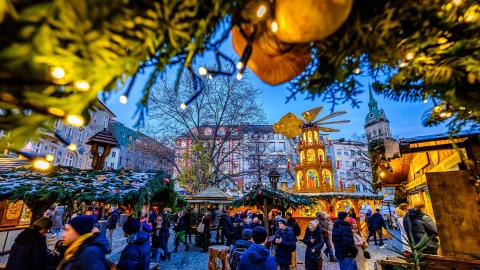3 bizarre Christmas traditions you've probably never heard of
One of the wonderful things about Christmas traditions is that what is considered traditional for you might be a world away from how others celebrate. Whether it’s a full-roast turkey dinner with all the trimmings or a family trip to KFC (the traditional Christmas dinner of Japan), there is no right or wrong way to celebrate the winter season.
The roots of many of these traditions can be traced back to almost ancient history. Whether celebrating the shortest day of the year or the survival of another year on earth - many rituals and traditions practised by paganistic religions over a thousand years ago can still be seen in our modern-day celebrations.
While many of our seasonal traditions help bring comfort, warmth and hope into some of the darkest nights of the year, there are other traditions out there that have quite the opposite effect. From burning a giant wicker goat to puppeteering, the corpse of a dead horse through the streets - here are three of the oddest winter traditions that are alive today.
Krampus
Much like children today, when the young residents of central Europe closed their eyes on December 5th each year, it must have been hard to fall asleep. However, while most children battled the excitement of seeing what St Nick would bring them for their good behaviour this year, some were kept awake by another emotion altogether: fear.
Each year while St Nick rewarded the good children of Germany, his travel companion, the Krampus, did quite the opposite. Half man, half goat, all nightmare: the Krampus would snatch up the bad children and stash them into his sack. Once he’d collected all the naughty children of the town, he’d steal them back to his lair, where they’d never be seen again.
The legend of the Krampus dates to pre-Christian pagan celebrations, where it’s believed that Krampus was the son of Hel, the Norse goddess of the afterlife. Today the Krampus has become a bit of a pop cult figure, featuring in supernatural television shows and horror films as a festive favourite. Celebrations of the Krampus take place across Germany and Austria, with parades of Krampus’ filling the streets each year to entertain crowds of tourists (and likely strike fear into the hearts of cheeky children too).
The Gävle Goat
When the association of tradesmen of South Gävle decided to build a giant version of the traditional Swedish Yule goat in 1966 in the town square to attract visitors, they couldn’t have anticipated just how explosive their publicity stunt would be. Assigning the construction of the goat to the local fire department, the goat's creators inadvertently couldn’t have known what an important role the fire department would play in the history of the Gävle goat.
Erected on the first of December, the Gävlebocken took two days to build. Standing at 13 meters tall, seven meters long, and weighing approximately 7 tonnes, the goat overlooked the town square for 31 days until New Year's Eve, when it met an unfortunate and untimely end. Burned down in the act of vandalism, the burning of the first Gävle goat heralded a new and anarchic Christmas tradition that has continued every year since.
Each year a new goat is erected in Gävle, and bets are placed on how long the goat will last. Over the years, 56 goats have been erected, and 38 have met their untimely end through arson, vandalism, and even hit-and-runs. Every December, local authorities have ramped up security efforts to ensure the safety of the goat, including the addition of fences, CCTV, aeronautic level fireproofing, and even round-the-clock security guards. However, this hasn’t stopped would-be vandals who have come up with new and increasingly absurd ways to destroy the goat each year, including ramming it with a Volvo and setting it on fire with a flaming bow and arrow.
Although a new tradition, the Gävle goat has captured fans' minds worldwide. If a trip to Sweden isn’t on the books for you, you can check in with the Gävle goat through a live stream or its very own Twitter account! Make sure to catch it quickly, though. It might not be around for much longer…
Mari Lwyd
If you were to hear and knock at the door and someone singing songs outside your house over the 12 nights of Christmas, you might be forgiven for thinking it was carollers. Residents in the south of Wales, however, have to think twice about their response before they open their doors. What lies on the other side might not be so friendly.
To be visited by Mari Lwyd might sound exciting, but you might be in for a bit of a shock when you first open your door and find yourself faced not with a cheery bunch of singers but with the skull of a dead horse. The Mari Lwyd is an old wassailing tradition where the Mari Lwyd, a hobby horse made with a horse's skull on a pole and covered by sackcloth, is escorted through the streets of south Wales. Much like other wassailing traditions, Mari Lwyd visits houses with her entourage, who will try to gain entry to the dwellings through song.
If Mari Lwyd visits you, you’re expected to sing a song to refuse her entry in return. So continues a call and response between the Mari Lwyd and homeowners until one side or the other relents. If the homeowners give in first, they’re expected to invite Mari Lwyd and her company inside their home and provide food and drinks.
















